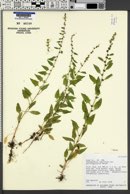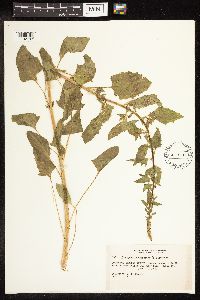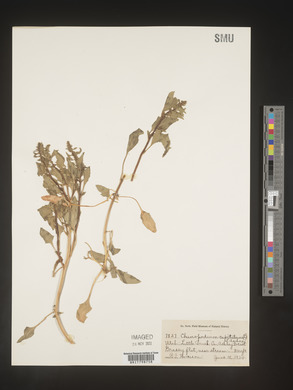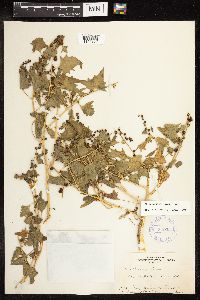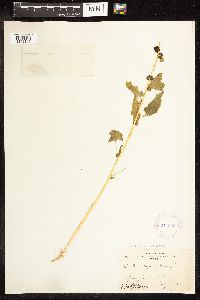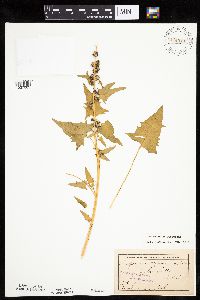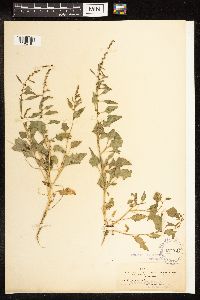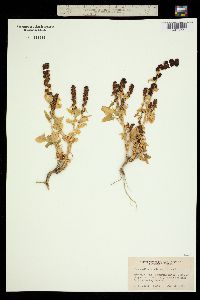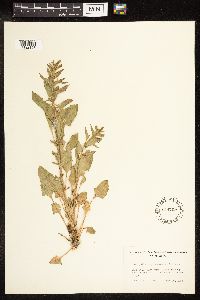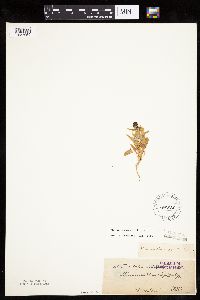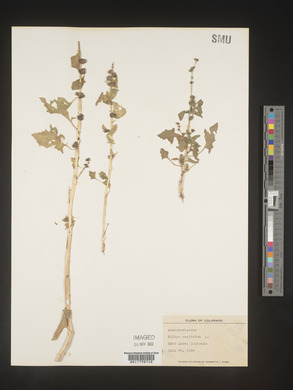Blitum capitatum
|
|
|
|
Family: Amaranthaceae
Blite Goosefoot, more...Over's goosefoot, Strawberry-Blite, Strawberry-Blite, strawberry-blite
[Chenopodium capitatum (L.) Ambrosi, moreChenopodium capitatum var. capitatum , Chenopodium capitatum var. parvicapitatum S.L. Welsh] |
Stems erect to ascending or decumbent, branched from base, 1.5-10 dm, glabrous. Leaves non-aromatic; petiole 1.5-10 cm; blade lanceolate, ovate, triangular, or triangular-hastate, 2.5-10 × 1-9 cm, base cuneate, truncate, or hastate, margins sharply dentate or entire, apex acute to acuminate. Inflorescences glomerules sessile on unbranched terminal spikes; spikes 5-20 cm; glomerules globose, 3-10 mm diam.; bracts leaflike, present only at base of inflorescence; flowers maturing from apex to base. Flowers: perianth segments 3, connate only at base, lobes lanceolate to ovate, 0.6-0.9 × 0.4-0.5 mm, apex acute, not keeled, glabrous, covering fruit at maturity, often becoming fleshy and red in fruit; stamens 3; stigmas 2, 0.1-0.4 mm. Achenes ovoid, fleshy or not; pericarp adherent, bright red to dark reddish brown or greenish red, smooth. Seeds 0.7-1.2 mm in diam., margins rounded; seed coat black, reticulate-punctate. 2n = 18. Leaf blades tapering or truncate-hastate at base, margins somewhat toothed or entire. Glomerules occasionally red, 3-5 mm diam., membranaceous in fruit. Fruiting summer-fall. Aspen groves, ponderosa pine, pinyon-juniper, Douglas fir-aspen, big sagebrush, meadows, and riparian habitats; 1400-3000 m; Ariz., Calif., Colo., Idaho, Mont., Nev., N.Mex., Oreg., Utah, Wyo. Leaf blades truncate to cordate-hastate at base, margins usually strongly toothed. Glomerules red, 6-10 mm diam., fleshy in fruit. Fruiting summer-fall. Moist to dry soil, sandy or grassy meadows, thickets, open woods, old fields of clearings in forest; 20-3000 m; Alta., B.C., Man., N.B., N.W.T., N.S., Ont., Que., Sask., Yukon; Alaska, Ariz., Calif., Colo., Conn., Idaho, Ill., Ind., Iowa, Maine, Mass., Mich., Minn., Mo., Mont., Nev., N.H., N.J., N.Y., Ohio, Oreg., Pa., S.Dak., Utah, Vt., Wash., Wis., Wyo.; introduced in Eurasia and elsewhere. Annual herb 15 cm - 0.6 m tall Stem: upright to ascending, branched at base. Leaves: alternate, on a 1.5 - 10 cm long stalk (lower ones often exceeding blade), 2.5 - 10 cm long, 1 - 9 cm wide, lance-shaped to triangular to arrowhead-shaped (hastate) with a broadly flat to tapering base and pointed tip, sometimes coarsely wavy-toothed (above lateral angles). Inflorescence: a 0.5 - 1 cm wide, stalkless, spherical cluster of flowers (glomerule), some of which together form a 5 - 20 cm long, terminal, leafless spike. Flowers: greenish, becoming red and fleshy in fruit, small, with three nearly distinct sepals and no petals. Sepal lobes 0.6 - 0.9 mm long, lance- to egg-shaped with a pointed apex. Stamens three. Stigmas two. Fruit: one-seeded (achene), enclosed in the persistent, incurved sepals, egg-shaped, red to reddish brown to greenish red, smooth, thin-walled. Wall (pericarp) adherent to the seed. Seed upright, black, 0.7 - 1.2 mm wide, egg-shaped, round-margined, wrinkled. Similar species: No information at this time. Flowering: May to August Habitat and ecology: Introduced from Eurasia. Woodland clearings (often after fire), roadsides, waste areas, and disturbed soil. Occurence in the Chicago region: non-native Etymology: Chenopodium comes from the Greek words chen, meaning goose, and podion, meaning "little foot," referring to the leaf shape of some species. Capitatum means "having a head." Author: The Morton Arboretum General: Annual, mostly 10-60 cm tall; stems erect, ascending, or decumbent, branching from the base, glabrous. Leaves: Alternate, simple, triangular, ovate, or lanceolate, 2.5- 10 cm long, 1-9 cm wide, reduced above, surfaces glabrous, margins sharply dentate to entire, base wedge- shaped, truncate, or hastate, apex acute to acuminate; petiole 1.5-10 cm long, often as long as the blades. Flowers: Inflorescence of glomerules, arranged in compound spikes; glomerules irregularly round, 4-7 mm in diameter; bracts leafy; perianth segments 5, distinct nearly to the base, covering fruit at maturity or not, surfaces farinose; flowers July-October. Fruits: Achene, ovoid, fleshy or not, bright red, dark reddish brown, or greenish red. Ecology: Wooded slopes, meadows, thickets, fields, forest clearings, moist soils; 2100-3000 m (7000-10000 ft); Apache, Coconino, Graham, and Mohave counties; widely distributed throughout Canada and northern to southwestern U.S. Notes: Two varieties occur in our area: var. capitatum has fleshy red glomerules (6-10 mm in diameter) and the bases of the leaf blades are truncate to cordate, with strongly toothed margins; var. parvicapitatum has membranous and often red glomerules (3-5 mm in diameter) and the bases of the leaf blades are wedge-shaped to truncate, with somewhat toothed to entire margins. Chenopodium rubrum (red pigweed, red goosefoot) is very similar to C. capitatum, but tends to have smaller glomerules (2-5 cm in diameter), perianth segments 3 or 4, membranous and green at maturity, not fleshy. Variety rubrum, distinguished by erect or ascending stems and deeply dentate leaf margins, is reported to occur in our area. Chenopodium capitatum is made into a lotion and used by the Navajo to treat head bruises and black eyes. Editor: Springer et al. 2008 Erect or ascending annual 2-6 dm, branched from the base; lower petioles often much exceeding the blades, the upper much shorter; lvs triangular or triangular-hastate, to 10 cm, acute, broadly truncate to an acute base, above the lateral angles entire to coarsely sinuate-dentate; fls in a limited number of globose clusters 5-10 mm thick at anthesis (to 15 mm in fr), these forming a terminal lfless spike, or some also in the upper axils; cal deeply 3-parted, the segments oblong to obovate, concave, at maturity commonly enlarged, fleshy, deliquescent-coalescent, and bright red; seeds erect, dull black, 0.7-0.8 mm wide, narrowly margined; 2n=18. Woodland clearings, often following a fire, and along roadsides in waste places; circumboreal, in our range s. to N.J., Ind., and Mo. (Blitum c.) Gleason, Henry A. & Cronquist, Arthur J. 1991. Manual of vascular plants of northeastern United States and adjacent Canada. lxxv + 910 pp. ©The New York Botanical Garden. All rights reserved. Used by permission. From Flora of Indiana (1940) by Charles C. Deam Reported from: Jefferson, Lake, St. Joseph, and Steuben Counties. ...... Indiana Coefficient of Conservatism: C = 5 Wetland Indicator Status: UPL Diagnostic Traits: leaves triangular-hastate, sinuate or coarsely dentate, lacking scurfy-scales beneath; flowers in dense glomerules (mostly 1-1.5+ cm thick), more or less lacking foliaceous bracts; sepals 3, becoming bright red and fleshy; seeds mostly vertical with acutish margin. |
|
|
|









